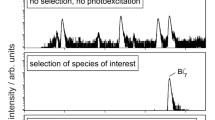Abstract
We have measured the fragmentation of Bi2 under electron impact ionization (45 eV) by measuring the relative intensity shift produced by a quadrupole magnet on an electrically neutral beam of atomic bismuth (magnetic moment ~ one Bohr magneton) and Bi2 (magnetic moment zero). The large discrepancy between the theoretically predicted and the observed shifts was ascribed to fragmentation in the ionization process. We obtain a fragmentation as defined by Kohl et al.1 of 2. 02 ±. 35. This is slightly higher than their estimates of 1. 54 ±. 20 and exemplifies the importance of fragmentation processes to cluster mass spectroscopy. The same measurement performed on a beam of Bi3 and Bi4 showed no intensity shift for the bismuth trimer. This result is ambiguous due to the unknown magnetic moment of Bi3. However, assuming a single Bohr magneton moment, to within our statistical accuracy, we could ascribe all of the Bi3 detected (Knudsen source) to fragmentation of Bi4 (the observed peak heights for Bi3 and Bi4 were identical.)
Access this chapter
Tax calculation will be finalised at checkout
Purchases are for personal use only
Preview
Unable to display preview. Download preview PDF.
Similar content being viewed by others
References
F. J. Kohl, O. M. Uy, K. D. Carlson, J. Chem. Phys. 47, 2667 (1967).
see e. g. “Proc. of the 3rd Int. Meeting on Small Part, and Inorg. Clust.,” Surf. Sci. 156 (1985).
W. D. Knight, Helv. Phys. Acta. 56, 521 (1983).
D. M. Cox, D. J. Trevor, R. L. Whetten, E. A. Rohlfing, A. Kaldor, Phys. Rev. В 32, 7290 (1985).
R. G. Keesee, R. Sievert, A. W. Castleman Jr., Ber. Bunsenges. Physik. Chem. 88, 273 (1984).
D. A. Greenwood, R. Brout, J. A. Krumhansl, Bull. Amer. Phys. Soc. 5, 297 (1960).
J. M. Dickson, Prog. Nucl. Tech. Inst. 1, 103 (1965).
K. P. Ziock, “Molecular Beam Studies of the Magnetic Moments of Small Metal Particles,” thesis, Stanford Univ. (1985).
K. Sattler, J. Mühlbach, E. Recknagel, Phys. Rev. Lett. 45, 821 (1980).
K. P. Ziock, W. A. Little, Rev. Sci. Inst., to be published.
L. Rovner, A. Drowart, J. Drowart, Trans. Faraday Soc. 63, 2906 (1967).
B. Eberle, H. Sontag, R. Weber, Surf. Sci. 156, 751 (1985).
Author information
Authors and Affiliations
Editor information
Editors and Affiliations
Rights and permissions
Copyright information
© 1987 Plenum Press, New York
About this chapter
Cite this chapter
Ziock, K.P., Little, W.A. (1987). Measurement of Bi2 and Bi4 Electron Impact Fragmentation Using Magnetic Polarization. In: Jena, P., Rao, B.K., Khanna, S.N. (eds) Physics and Chemistry of Small Clusters. Springer, Boston, MA. https://doi.org/10.1007/978-1-4757-0357-3_50
Download citation
DOI: https://doi.org/10.1007/978-1-4757-0357-3_50
Publisher Name: Springer, Boston, MA
Print ISBN: 978-1-4757-0359-7
Online ISBN: 978-1-4757-0357-3
eBook Packages: Springer Book Archive




